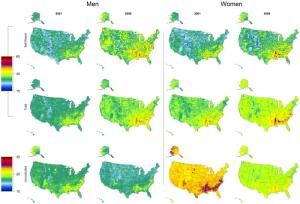
Two interesting pieces of research about high blood pressure hit the news this week: one, a map of the United States showing those areas with the greatest number of people with hypertension was published by the Institute for Health Metrics and Evaluation (IHME) at the University of Washington. That study showed a hypertension belt in the Southeast, and the lowest levels of hypertension in Colorado. Item of interest number two is a report in the British Medical Journal with persuasive evidence that cutting down on salt and increasing levels of potassium in our diet will have major health and cost benefits across the world. BMJ looked at three studies of other studies. One, which examined the effects of modest salt reduction on blood pressure, hormones, and blood fats (lipids) from 34 trials involving over 3,000 adults, found a modest reduction in salt for four or more weeks led to significant falls in blood pressure in people with both raised and normal blood pressure. A second study, which looked at 56 studies found that reduced salt intake reduces blood pressure and has no adverse effect on blood lipids, hormone levels, or kidney function, and that lower sodium intake was also associated with reduced risk of stroke and fatal coronary heart disease in adults. A third study, which looked at potassium intake and health from 33 trials involving over 128,000 healthy participants, found that increased potassium intake reduces blood pressure in adults, and was linked with a 24 percent lower risk of stroke. Read more in Science Daily.
